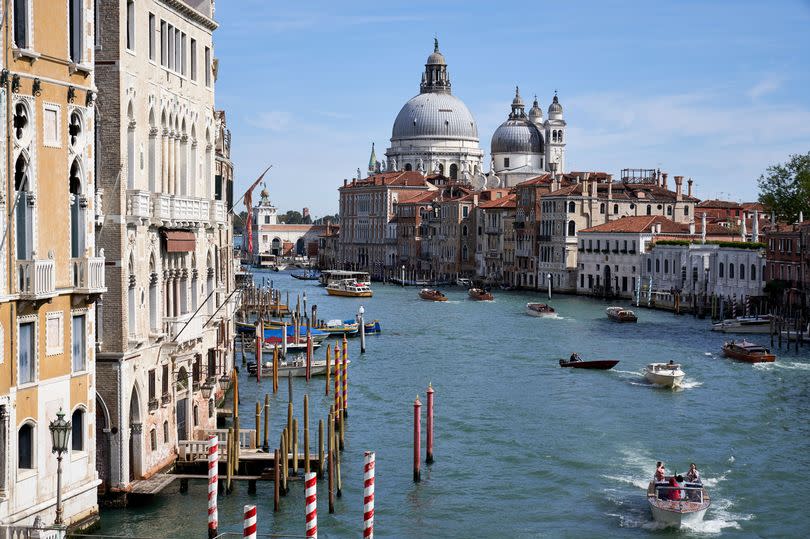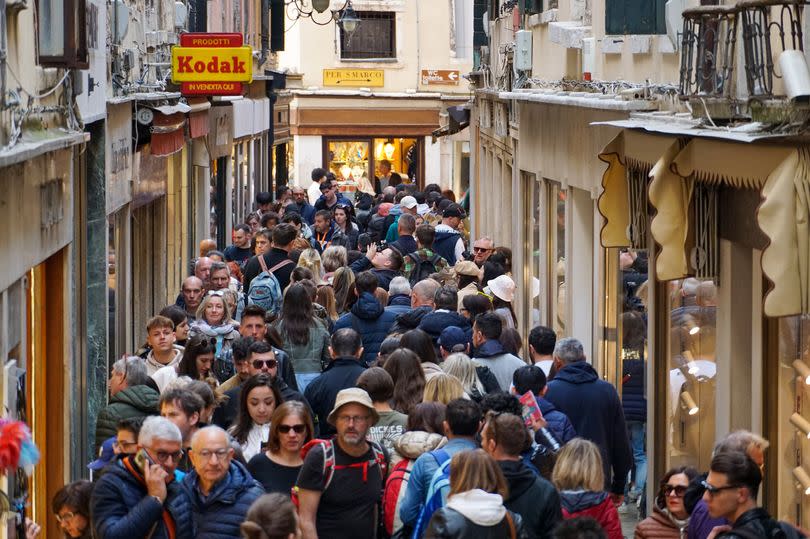Venice tourists warned of new charge this spring and summer - full list of dates

One of Italy's most popular tourist destinations is charging day-trippers a new entry fee, in hope of discouraging visitors from arriving on peak days. Authorities in Venice are trialling the €5 charge on 29 specific dates this spring and summer, with holidaymakers facing a fine of up to €257 if they fail to pay.
Authorities say the aim is to reduce crowding during the busiest periods and make the city more liveable for residents. Signs advising arriving visitors of the new requirement during the test phase have been erected outside the city's main train station and other points of arrival.
The first day of the trial period begins today (April 25), with the full list of dates outlined below. Some 200 stewards have been trained to politely walk anyone unaware of the five euro (£4.28) fee through the process of downloading a QR code.
Read more: New Canary Islands rules for Brits after protests and anti-tourist graffiti
Read more: 'Gateway to the Med' holiday destination where Brits are welcome
A kiosk has been set up for those not equipped with a smartphone. Once past designated entry ports, officials will carry out random checks for QR codes that show the day-tripper tax has been paid or that the bearer is exempt.
Transgressors face fines of 50-300 euros (£53-£257). The requirement applies only for people arriving between 8.30am and 4pm. Outside of those hours, access is free.
“We need to find a new balance between the tourists and residents,” said the city’s top tourism official, Simone Venturini. “We need to safeguard the spaces of the residents, of course, and we need to discourage the arrival of day-trippers on some particular days.”
When do the charges apply and who to?
According to information shared by the Comune di Venezia, the city's officials, these are the dates in 2024 when the fee will be required:
April 25, 26, 27, 28, 29, 30
May 1, 2, 3, 4, 5, 11, 12, 18, 19, 25, 26
June 8, 9, 15, 16, 22, 23, 29, 30
July 6, 7, 13 and 14
Translated information for tourists on the Comune's website states: "Entry to the city of Venice is subject to payment of an access fee, unless the visitor falls into one of the categories that entitle them to exemption from payment.
"The access fee is not charged from 4p.m. to 8.30am. Registering and obtaining the appropriate exemption voucher is required to benefit from the exemption.
"Residents of the Municipality of Venice and individuals born in the Municipality of Venice are excluded from paying the access fee: they are not required to obtain the exemption voucher and can prove their exemption status by presenting a document certifying it.
"Minors under the age of 14 are excluded from the payment of the access fee: to prove their age, if it is not apparent, the presentation of an identity document is accepted as sufficient proof."

Why is this being trialled?
Venice has long suffered under the pressure of over-tourism, but officials say that pre-pandemic estimates ranging from 25 million to 30 million visitors a year — including day-trippers — are not reliable and that the pilot project also aims to come up with more exact figures to help better manage the phenomenon.
By contrast, registered visitors spending the night last year numbered 4.6 million, according to city figures, down 16 per cent from pre-pandemic highs. Mr Venturini said the city is strained when the number of day-trippers reaches 30,000 to 40,000.
Its narrow alleyways are clogged with people and water taxis packed, making it difficult for residents to go about their business. Not all residents, however, are persuaded by the new system in dissuading mass tourism, and say more attention needs to be paid to boosting the resident population and services they need.
Venice last year passed a telling milestone when the number of tourist beds exceeded for the first time the number of official residents, which is now below 50,000 in the historic centre with its picturesque canals.
“Putting a ticket to enter a city will not decrease not even by one single unit the number of visitors that are coming,” said Tommaso Cacciari, an activist who organised a protest on Thursday against the measure.
“You pay a ticket to take the metro, to go to a museum, an amusement park; you don’t pay a ticket to enter a city. This is the last symbolic step of a project of an idea of this municipal administration to kick residents out of Venice,” he said.
Mr Venturini said about 6,000 people had already paid to download the QR code, and officials expect paid day-tripper arrivals today (Thursday) to reach some 10,000. More than 70,000 others have downloaded a QR code denoting an exemption, including to work in Venice or as a resident of the Veneto region.
People staying in hotels in Venice, including in mainland districts like Marghera or Mestre, should also get a QR code attesting to their stay, which includes a hotel tax. The tourist official says interest in Venice’s pilot programme has been keen from other places suffering from mass tourism, including other Italian art cities and cities abroad such as Barcelona and Amsterdam.

 Yahoo News
Yahoo News 
